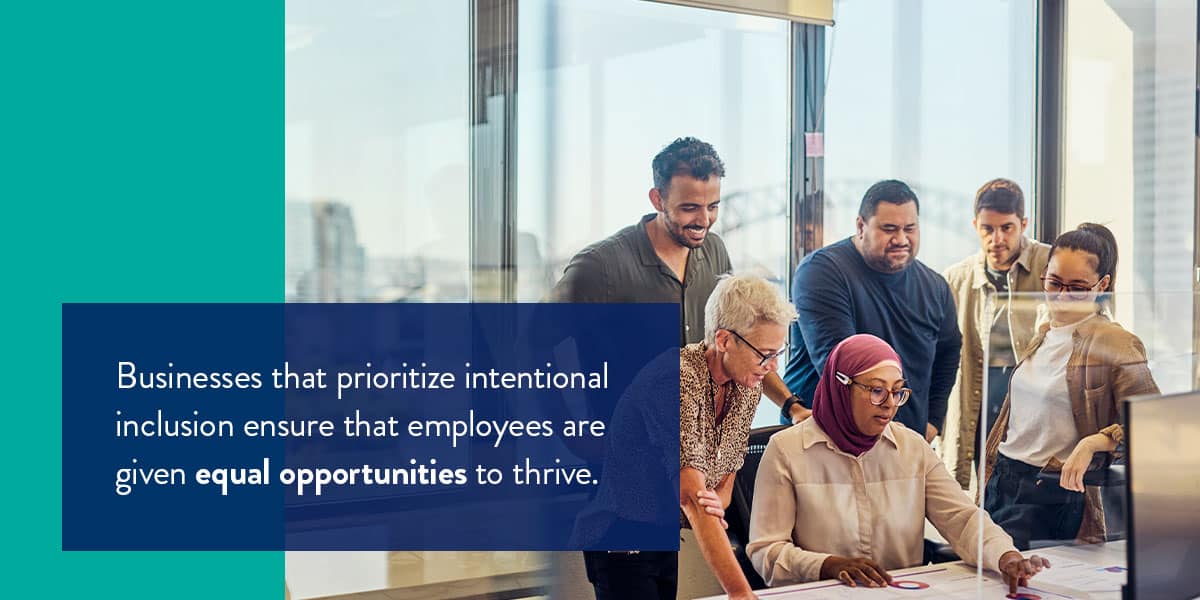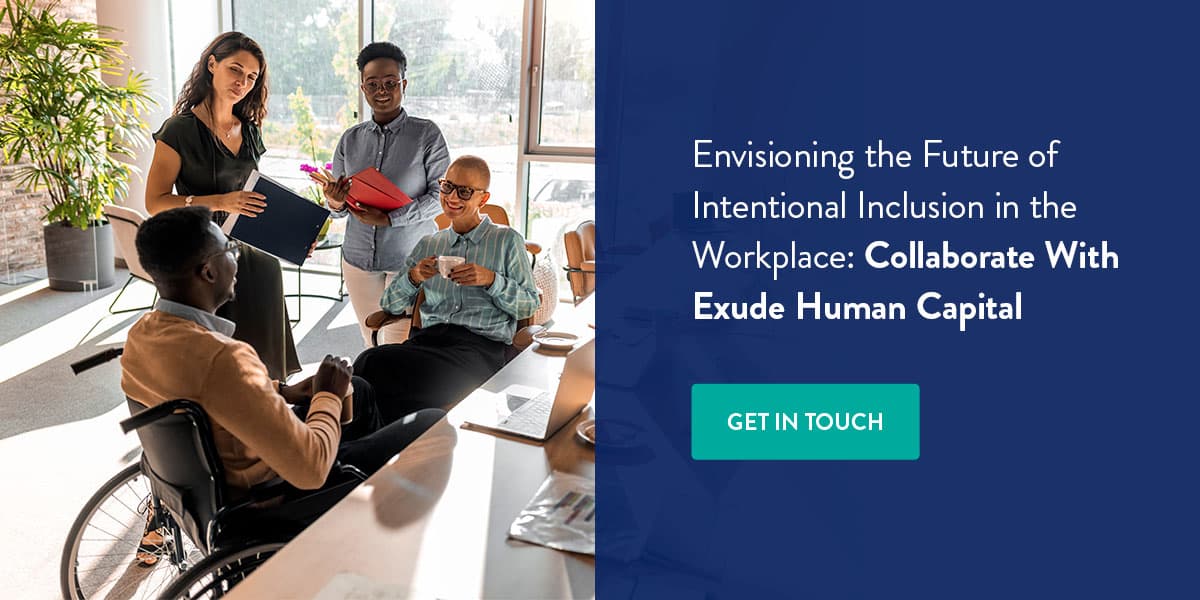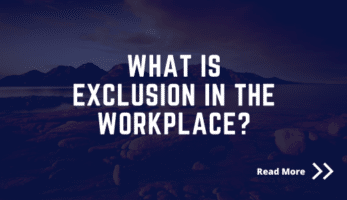Equity and Inclusion
Promoting Equal Opportunities Through Intentional Inclusion in the Workplace

Every person has unique qualities and different backgrounds that enable them to contribute to the workplace. Your organization should prioritize diversity and inclusion to make everyone feel like their differences are celebrated and foster a welcoming environment.
Intentional inclusion is a valuable approach that focuses on ensuring everyone has the opportunity to thrive. Let’s look at ways your business can foster intentional inclusion in the workplace.
- Understanding the Importance of Intentional Inclusion in the Workplace
- Key Strategies to Foster Intentional Inclusion in the Workplace
- Intentional Inclusion in the Workplace: Benefits and Challenges
- The Crucial Role of Leadership in Promoting Intentional Inclusion in the Workplace
- Envisioning the Future of Intentional Inclusion in the Workplace: Collaborate With Exude Human Capital
Understanding the Importance of Intentional Inclusion in the Workplace
Diversity and inclusion in organizations should be the priority, but what does it mean to be intentionally inclusive?
Intentional Inclusion Definition
Organizations with an intentionally inclusive culture provide equal access to resources and opportunities for people who might otherwise be excluded, such as members of marginalized groups. The organization ensures that employees from underrepresented groups are included in the company’s culture and feel valued rather than tokenized. In an inclusive environment, everyone has the ability to reach their full potential.
Intentional inclusion requires more than words. You have to go beyond discussing inclusion by displaying inclusion with deliberate actions. Some examples of inclusion in the workplace include providing Muslim employees with space for prayer during Ramadan or accommodating employees with physical disabilities by making adjustments that allow them to move freely.
The Role of Intentional Inclusion in Fostering Equal Opportunities
People from marginalized communities sometimes feel powerless, and you do not want to create a work environment that reinforces that feeling. Businesses that prioritize intentional inclusion ensure that employees are given equal opportunities to thrive. For example, an inclusive organization could make reasonable accommodations for employees who are first-generation college graduates by providing career coaching services.

Additionally, all employees should be encouraged to contribute to important company discussions, which can empower them to share unique ideas and feel a sense of belonging. Feeling a sense of belonging is vital for people from underrepresented groups to feel included in a company’s vision.
Key Strategies to Foster Intentional Inclusion in the Workplace
Intentional inclusion is not achieved immediately, and a lot of planning and thought goes into reaching your goal. These are some strategies you can implement that will guide you on the journey toward intentional inclusion.
Implementing Intentional Inclusion Policies
An essential step toward achieving diversity and inclusion in the workplace involves reflecting on growth areas. Look at your current practices and evaluate whether they are inclusive of underrepresented people. If not, this is an excellent opportunity to create new inclusive policies.
For example, you might make company-wide changes to the recruitment and promotions processes to ensure equal opportunities for all candidates. You could also implement flexible working hours or make changes to your office, like adding ramps and gender-neutral bathrooms.
The Necessity of Training and Education in Cultivating Intentional Inclusion
Intentional inclusion is a team effort. So, how do you become intentionally inclusive? Training and education. Exclusion is hurtful even when it’s unintentional, which is why programs like diversity training are important. Diversity training teaches people the necessary skills to interact with people from different cultural backgrounds. It ensures that employees understand the necessity of diversity and know how to approach people with the required level of sensitivity. Additionally, training and education can enhance communication skills and build a positive work environment.
Intentional Inclusion in the Workplace: Benefits and Challenges
Cultivating an organization that prioritizes inclusion leads to various benefits. However, some challenges are to be expected.
The Multitude of Benefits of Intentional Inclusion
There are many benefits of intentional inclusion in the workplace:
- Gaining multiple perspectives: In any industry, it’s beneficial to gain opinions from many sources, and employees from diverse backgrounds can offer unique perspectives in the workplace. Gaining insights from a variety of diverse perspectives can lead to creative and innovative solutions for solving problems.
- Connecting with clients and customers: With a diverse workforce, companies can better ensure that the messages they’re putting out to audiences are inclusive and not insensitive. Additionally, customers and potential clients see inclusive enterprises as more socially responsible and attractive, which is essential in a socially conscious world.
- Higher employee engagement: When employees feel welcomed, valued and empowered, they tend to have higher motivation and engagement levels. In the long run, inclusive organizations will experience lower staff turnover and higher productivity.
Navigating the Challenges of Intentional Inclusion: Overcoming Obstacles
Some barriers may arise as you strive to create an inclusive environment, but like most challenges in life, you can resolve them if you are willing to make an effort. The first barrier most organizations face is unconscious biases affecting decisions and perceptions. These biases can occur during hiring and even during day-to-day operations. Part of overcoming unconscious biases involves providing diversity training to employees at all levels.
A lack of diversity in leadership in the workplace often leads to employees from marginalized groups feeling as if they can only advance to a certain point. Addressing the issue requires developing diversity-focused leadership and mentorship programs.
After making policy changes, some employees might resist the changes. In these cases, leadership has to set an example and demonstrate their commitment to diversity and equity. If necessary, you should allocate more resources to ensure the successful implementation of inclusion programs.
The Crucial Role of Leadership in Promoting Intentional Inclusion in the Workplace
Building a diverse and inclusive workforce is the responsibility of HR managers, as well as company leaders. Leadership should model actions that show a commitment to inclusion, and they should address any forms of discrimination they witness or that are reported.
Steering the Ship: How Leadership Can Foster a Culture of Inclusion
When creating an inclusive environment and implementing new programs, leaders should intentionally solicit perspectives from employees from underrepresented groups. Employees should be encouraged to give feedback on ways the organization can improve workplace culture, ensuring that inclusive decision-making and decisions will translate to all employees feeling valued and seen.
Leaders can also oversee hiring and promotions to ensure employees from all backgrounds are being compensated fairly, which assists in addressing systemic inequalities related to pay gaps. Another strategy is for leadership to undergo diversity training first so that they can vouch for its benefits and importance as the program gets rolled out to employees.
There’s no questioning the fact that leadership has a direct impact on an organization. When leadership fosters inclusion, the benefits ripple through the rest of the company and the inclusion efforts are more likely to be successful.
Envisioning the Future of Intentional Inclusion in the Workplace: Collaborate With Exude Human Capital

Intentional inclusion benefits marginalized employees and the organization itself. With a commitment to inclusion, your organization will achieve innovation, creativity and higher productivity.
Creating an intentionally inclusive workplace takes dedication, and you do not have to do it alone. Exude Human Capital is your trusted advisor in all things people. Our Inclusive Culture Alignment tool can assist you on your journey to intentional inclusion. After completing a self-assessment, we’ll analyze your results and help you establish a plan for becoming more equitable and inclusive. Contact us today to get started!







